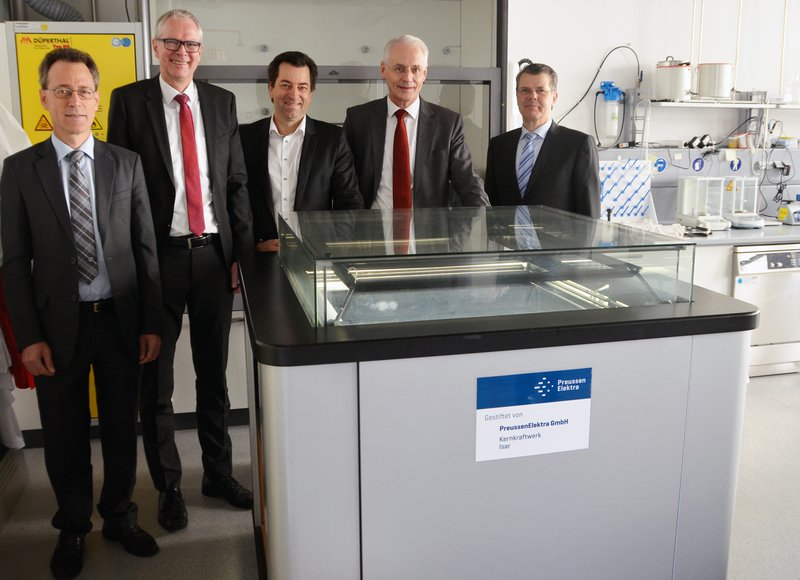University of Applied Sciences Landshut has achieved a real coup. In future, students will be able to see naturally ionising radiation in a diffusion cloud chamber. The cloud chamber used to be in the information centre of Isar Power Plant (IPP) and was used for visitor support. However, due to spatial restructuring, it is no longer needed there. The official handover in one of the University’s laboratories was attended by the University President Prof. Dr. Karl Stoffel, the IPP Site Director Carsten Müller, Bernd Gulich of the Communication Department of the IPP, the Dean of the Electrical and Industrial Engineering Faculty Prof. Dr. Fritz Pörnbacher and the course manager of the Process Management and Resource Efficiency Master's degree Prof. Dr. Stefan-Alexander Arlt.
“We are pleased to be able to make a small contribution with this donation to the teaching and research at University of Applied Sciences Landshut and that the cloud chamber will continue to be put to good use,” emphasised Müller. Stoffel thanked Müller on behalf of the entire University. “With the diffusion cloud chamber, we can demonstrate radiation even more clearly to our students.” Prof. Pörnbacher and Prof. Arlt were also impressed by the University's latest acquisition. Very few universities can call a diffusion cloud chamber of this size their own, stated Pörnbacher. “We are very proud and happy that we will be able to work with it in future,” added Arlt. “This will undoubtedly enhance our seminars still further.”
How the diffusion cloud chamber works
Since it was created around 4.5 billion years ago, the entire plant has been slightly radioactive and emitting (ionising) rays. The earth is also hit by such radiation from space. In a cloud chamber alpha particles, electrons, protons and mesons create visible cloud tracks. The tracks of the individual particles look different. As a result, it is possible to see which particle has flown through the cloud chamber and whether there have been any collisions or deflections during its flight. Decays of radioactive nuclides also generate characteristic tracks in the cloud chamber and can therefore be detected. The radioactive radiation ionises individual gas molecules in the chamber. These gas molecules act as condensation nuclei for further molecules, whereby these condense and visible cloud tracks are created along the flight path of the particles. The principle is similar to that of an aircraft flying at high altitude. The aircraft itself cannot be seen from earth, but the contrails can.
Photo: Landshut University of Applied Sciences
(free to use if source cited)

